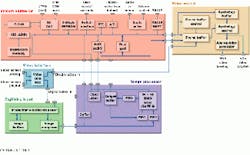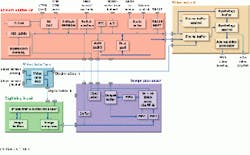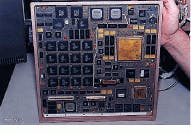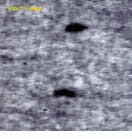PORTABLE SYSTEMS APPLY infrared technology TO DETECT AND CLASSIFY MINES
PORTABLE SYSTEMS APPLY infrared technology TO DETECT AND CLASSIFY MINES
By John Haystead, Contributing Editor
Inexpensive antipersonnel mines can stop an infantry unit in its tracks, while more expensive versions can destroy tanks. Currently, there are more than 110 million active land mines located in Afghanistan, Cambodia, Vietnam, Central America, and Kuwait. Little wonder then that land-mine detection is one of the US Army`s top priorities.
To counter such threats, the Night Vision and Electronics Sensors Directorate (Ft. Belvoir, VA) is developing a number of countermine systems. One such system is a portable infrared (IR) mine-detection system developed by Lockheed Martin (Orlando, FL). Using parallel image processing, automatic target recognition, and neural-network algorithms, the system can detect and identify buried land mines at distances to 10 m. Lockheed has built six prototypes for the Army as part of an advanced technology-demonstration program.
Functioning as the front-end of Lockheed`s portable IR mine detector, an Inframetrics (Billerica, MA) Infracam 256 ¥ 256 IR camera with a 10-bit dynamic range and a thermal sensitivity of 0.1C detects IR images and outputs RS-170 signals to a Common Image Signal Processor (CISP). To cool the detector array to operating temperature, the camera uses a closed-cycle cryogenic cooler that must be powered 10-15 minutes prior to use.
The modular prototype CISP consists of a frame grabber, image processor, system controller, and video output controller. Because the system is modular, the frame grabber and video output controller can easily be replaced, allowing different sensors and displays to be supported (see Fig. 1).
After IR images are digitized, portions of them are extracted for processing in a parallel Geometric Algebraic Parallel Processor (GAPP) image-processing array. Using a custom address generator, sample 64 ¥ 48 tiles are extracted from stored 640 ¥ 480 IR images. The system controller module then selects specific tiles to be analyzed according to a preprogrammed list of criteria. A TMSC40 processor on the system controller board runs these algorithms, while a second C40 GAPP controller runs high-level image-processing commands. Another application-specific IC translates these commands into microcode for the GAPP on the image-processor board.
The GAPP array comprises 16 GAPP ICs arranged in a 4 ¥ 4 matrix. Each IC is composed of a 16 ¥ 12 processing element so that, in total, the image processor functions as a 64 ¥ 48 array with a total of 3072 processing elements. "At 6 BOPs, the GAPP performs automatic mine identification in real time," says Bert Garcia, project leader for the Army`s Hand-Held Stand-off Mine-Detection System at Ft. Belvoir.
The CISP assumes that the most significant area of interest in the IR image is near the center of the camera`s field of view (see Fig. 2). Images are therefore processed from the center outward. Object range is determined by an inclinometer mounted to the user`s helmet. Range is then estimated from the relative elevation of objects in the image.
Running the GAPP
In operation, the GAPP executes a series of algorithms that enhance and search each image tile for features relative to image geometry, thermal characteristics, and background contrast. Because, in any given location, the ground is composed of uniform natural materials that heat and cool at rates different from those of manmade materials, mines act as thermal insulators or emitters. In either case, the mine`s thermal distribution contrasts with that of the surrounding environment, and its size and shape can be detected and measured. Because the thermal imager can detect a temperature difference in the 50-mK range, it can effectively detect the presence of land mines.
"Most mines can be identified from size and shape," says Victor Sorondo, Lockheed Martin manager of Image and Signal Processing. They usually have an eliptical or circular geometry with well-defined edges and surface area. The GAPP formulates an electronic report, identifying objects as possible targets, lists their characteristics, and passes the data to the system for classification and display. The neural-network classifier does not need to know in advance every possible type of mine it may encounter, but can automatically adapt itself to recognize new parameters.
CISP system software is based on Lockheed Martin`s automatic target-recognition and neural-network algorithms. Software-development tools and cross-compilers running on Sun Microsystems (Mountain View, CA) UNIX workstations with X-Windows interfaces allow developers to code the GAPP in either C, C++, or ADA programming languages and then translate it to the GAPP`s 64-bit microcode.
Head-up display
Because the GAPP`s processing time is determined by the number of objects in the frame, the system controller trades off the number of tiles processed or reduces the frame-update rate to avoid overlaying symbology on a "stale" image. Typical execution times for image-processing functions performed by the GAPP are shown in the table on p. 40. The system also can recognize when the headset is rapidly moving and suspends tile processing until the operator has fixed on an area of interest.
While the GAPP is processing tiles, real-time IR video is displayed on a helmet-mounted eyepiece. A video output controller superimposes this imagery with graphic symbols generated by the image processor
Manufactured by Kopin (Taunton, MA), the system`s eyepiece is a 640 ¥ 480 LCD with a 10-bit/pixel dynamic range that operates similarly to a head-up display. Because IR images are projected onto reflective glass, operators can simultaneously see visible and IR images. Although the human eye is sensitive to multiple colors, it can at best discriminate no more than 6-7 bits of resolution per pixel. Because of this, Lockheed is now evaluating a new process and display technology that will pseudocolor images by converting the 10-bit thermal data into three different 8-bit color bands.
A simultaneous view of the real world is necessary because potential obstacles may occur naturally at or near the same temperature of the surrounding environment and will not be visible in the IR. "We`d like to present a composite image of both visible light and IR imagery, but this would require an additional camera," says Lockheed`s Sorondo.
In advanced technology demonstrations at the Aberdeen Proving Ground in Aberdeen, TX, Yuma, AZ, and Fort AP Hill, VA, Lockheed`s portable mine-detection system successfully met overall performance requirements. However, the limitations of IR technology were also brought to light. Infrared systems are impacted by thick foliage and tall grass. While tested in the open-slag terrain of Yuma, the system operated successfully at more than 10 m; in 18-in. grass at Aberdeen, only land mines approximately one meter away could be detected.
To compensate for these limitations, the US Department of Defense is looking at multisensor approaches to mine detection, according to Paul O`Connor, Lockheed Martin manager of Advanced Systems Research and Technology. Development efforts are now focused on integrating IR technology with ground-penetrating radar and magnetic detection.
Other display technologies can also provide significant improvements. For example, the virtual retinal display (VRD) from Microvision (Seattle, WA) directs a pinpoint beam of light onto the operators retina, and full-color images appear to be at arm`s length. VRDs require only a small aperture in front of the eye and provide a brighter, higher-resolution, higher-contrast image than conventional projection displays.
FIGURE 1. To allow interfaces to be easily upgraded, the IR imaging system consists of a system controller with separate plug-in image processing, digitizing and video-interface boards. The image-processor board (inset) is an SIMD design that can process pixels on a per-processor basis.
FIGURE 2. In IR mine detection, field of view and sensitivity are the two primary sensor parameters. In addition to covering a reasonable area, the system must be able to capture subtle difference in background signature, yet not overwhelm the processor with clutter and reduce algorithm performance.



